
The story of Christmas began when three wise men saw something strange in the sky and decided to investigate.
Anyone who’s seen a UFO can easily relate to what those wise men might have been thinking, and that’s what makes the images in these paintings so compelling.
Many unusual aerial objects depicted in paintings between the 14th to the early 18th century look, at first glance, like modern-day UFO sightings.
It’s easy to wonder why artists of those long-ago centuries seemed obsessed with including these curious objects in scenes surrounding the stories of the birth and death of Jesus Christ.
The first example here is a wall mural, or fresco, from 1350, “The Crucifixion,” artist unknown, in the Visoki Decani Monestary in Kosovo, Serbia. Two odd-looking objects with “pilots” can be seen in the sky on both sides of Jesus.
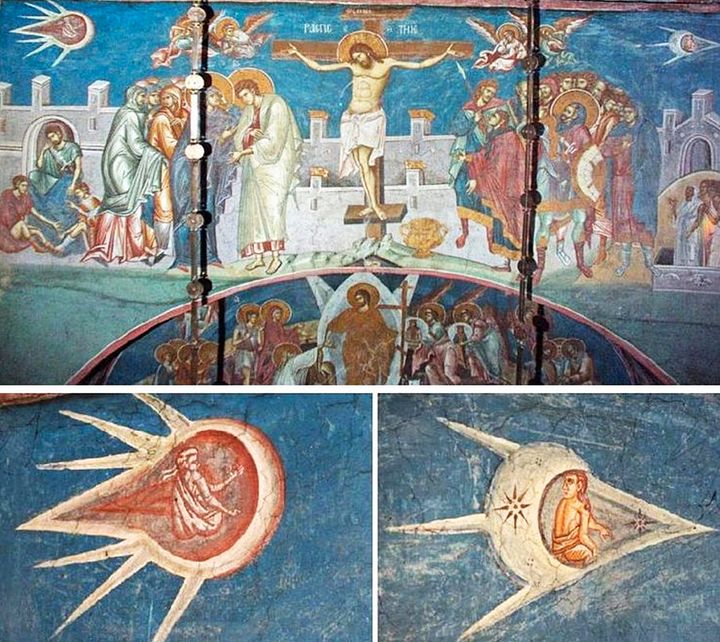
"As odd as the details in the upper left and right sections of the Kosovo fresco may seem to modern eyes, they, in fact, refer to something readily familiar: the sun and the moon," according to Dennis Geronimus, associate professor of Italian Renaissance art and chair of the Department of Art History at New York University.
"The strangeness, to our sensibilities, no doubt lies in the fact that the two celestial bodies are personified by two crouching figures that are shown as inhabiting them: producing a kind of 'man in the moon' effect," Geronimus told HuffPost in an email.
He added that the apparent simultaneous presence of both the sun and moon, "alludes to mentions in several of the Gospels of the sky growing dark in daytime during Christ's crucifixion."
Our next painting, from 1486, is "The Annunciation with Saint Emidius," by Carlo Crivelli, that resides at the National Gallery in London. It shows a circular object shooting a thin beam of light down to the Virgin Mary.
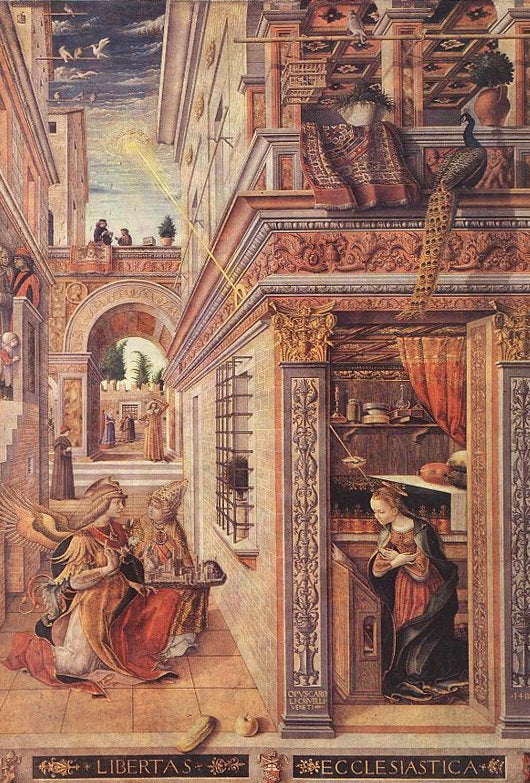
"The golden beam descending from a cloud bank through an opening in Mary's bedroom wall, and reaching its destination at the Virgin's head, carries along its path the Holy Spirit," said Geronimus. "Characteristically, here it assumes the form of a white dove and symbolizes the incarnation.
"The Virgin Mary is shown as being infused -- or, to put it literally, impregnated -- with the Holy Spirit, a miraculous event that will lead to the birth of Christ."
The following image is a close-up of that circular cloud bank.
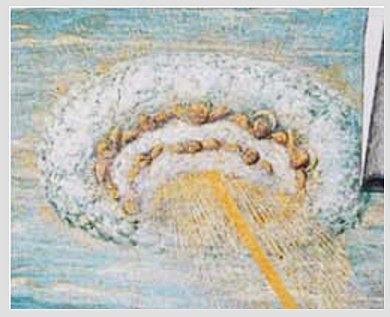
Computer scientist Jacques Vallee agrees with Geronimus' take on these works of art. But he wonders why this form of symbolism seems to crop up in so many works of art from these years.
"It's certainly true that these paintings do not represent actual sightings by the artist or contemporary events of the scene," Vallee told HuffPost. Vallee and his co-author, Chris Aubeck, are about to publish an extensive update to their 2010 book, "Wonders in the Sky," which looks at reports of strange aerial objects reported by many people -- including scientists -- in pre-20th century accounts, beginning in 1879 and moving backward in time to biblical sightings.
"The value of it, scientifically, is that now we can anchor the beginning of the UFO phenomenon into real, documented history," Vallee said.
"You cannot simply say that, because somebody saw something round in the sky in medieval times, it's the same phenomenon that people see today. We are not making that statement. We're simply describing what people saw and the phenomena associated with it as a contribution to the overall study of the history of the phenomenon."
Vallee (see image below) was a principal speaker in 1978 at the only major United Nations UFO presentation in history, where he urged serious, international, unbiased research, focusing on those UFO reports considered truly unidentified.

"I think the skeptics are right in saying that many of the reports have to do with things that, today, we recognize as comets and meteors and other natural phenomena. And that's fair. We go through that and eliminate those and we keep the ones that are unidentified," Vallee said.
In the late 1960s, Vallee's early UFO research was so respected by the United States Air Force that his books were recommended reading to cadets at the Air Force Academy in Colorado.
He points out how many people misinterpret unexplained objects seen in old paintings.
"We don't go into ideology. We're not saying it's proof of alien anything. We're saying there is a phenomenon and it has some of the characteristics of the modern phenomenon, and we let it go at that. You still have to account for differential descriptions because of the changes in the cultures and the changes in the media, through which the data has arrived to us."
Our next painting to consider, from the 15th century, "Madonna and Child with the Infant St. John," is attributed to more than one artist and is located at the Palazzo Vecchio Museum in Florence, Italy. Mary, mother of Jesus, is seen looking down while, in the background, something unusual is taking place.
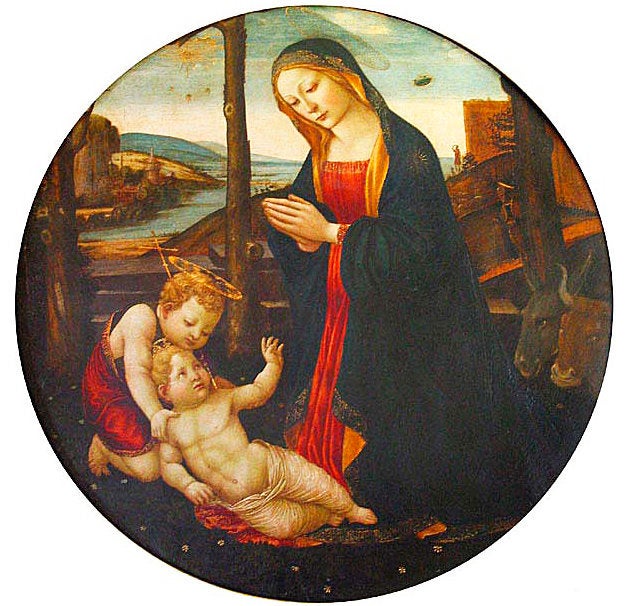
What appears as a domed UFO is hovering in the sky while a man and his dog are standing on a ledge staring up at it. These details are revealed in the following composite image.
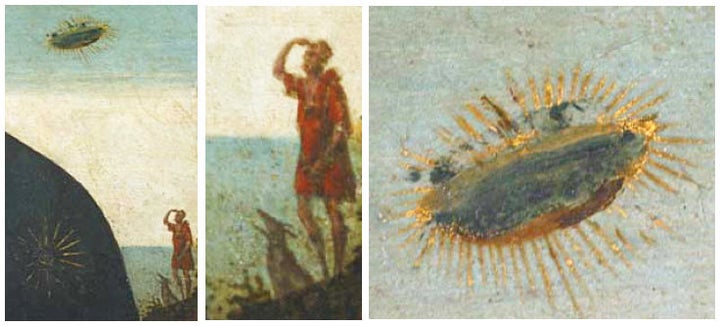
"The dark blue, almond-shaped form, emitting golden rays, constitutes a symbol that was very common in the Renaissance, when this [circular panel, for private devotion] was painted," said Geronimus.
"It alludes to the announcement of Christ's birth in Bethlehem to the shepherds, as told in the Gospel of St. Luke (2:8-14). The awed shepherd and his trusted dog are easy to spot here. Rather than depicting an angel as the divine messenger, however, this Florentine master represents the sign more naturalistically -- and obliquely: as a celestial phenomenon."
Our final Christmas painting, from 1710, "Baptism of Jesus," created by Arendt de Gelder, is at the Fitzwilliam Museum in Cambridge, UK.
It depicts a large, circular object shooting beams of light down toward Jesus.
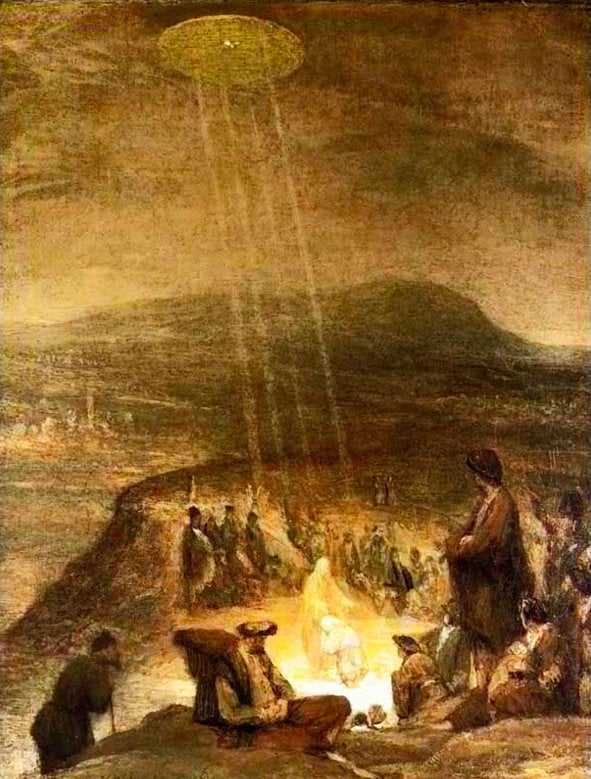
"The four rays that pass down from the sky to illuminate the kneeling figure of Christ, as he is baptized by St. John, refer to the divine power of the Holy Spirit, as embodied again by the white dove hovering at the center of the radiant cloud from which the rays emanate," said Geronimus.
Here's a close-up of that circular cloud with the light beams.
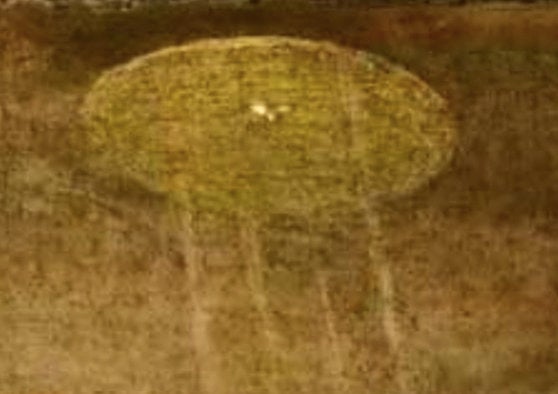
"What is unusual, really, about this composition is not so much the literal quality of the Holy Spirit's celestial origins, but the fact that the baptism is here imagined as seemingly a nocturnal event.
"Suffice it to say," Geronimus concludes, "none of these painted details amount to early modern UFO sightings, which isn't to say that the Kosovo muralist's or Carlo Crivelli's contemporary audiences did not believe in otherworldly beings or supernatural events."
